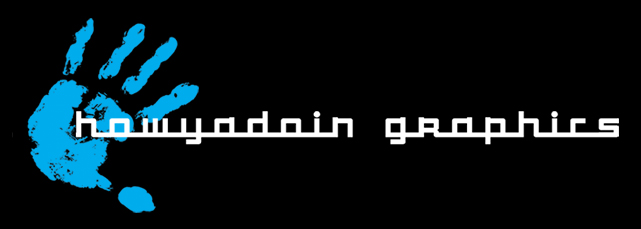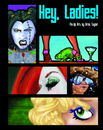skip to main |
skip to sidebar
Hey, it's high time for another installment. This time I'm here to talk about interference and iridescent paints. I've been using both for awhile now (which is to say, a whopping two years), but it never occurred to me to try mixing them with other colours.
Then after a chance remark from an artist friend of mine, I went looking around Golden's website and read an interesting tip about mixing interference colours with a small amount of black, to get a deeper, richer mix. (For the uninitiated, interference colours change between a bright opalescent color and a more subtle complementary colour, depending on the viewing angle. There's a fairly complex mathematical explanation involving the polyatomic interference that results from the meeting of two wavetrains of white light, but for our purposes here, let's just say that the paint contains shiny particles of mica.)Anyhow, armed with this seemingly minor tip, I got out the paints and tried mixing a few combinations of interference colours and Mars black on the back of a scrap piece of illustration board. Some of them looked great, and others were less than satisfying. But since I was already in laboratory mode, I started adding other paints to the interference colours - some opaque, some transparent. From there things led pretty naturally to iridescents (highly-reflective paints with metallic additives - mica, iron oxide, titanium, etc.).
Before I knew it, I'd come up with a whole slew of options and was practically cackling like a madman. Then I tried photographing the results, which was a challenge in itself. After several tries, I finally came up with these two photos:

 Here's a list of the combinations depicted in the photos:A - interference green + mars blackB - interference orange + mars blackC - interference orange + pyrrole orangeD - interference blue + mars blackE - interference blue + cerulean blueF - interference blue + phthalo blueG - interference green + phthalo greenH - interference violet + mars blackI - iridescent pearl + alizarin crimsonJ - interference blue + cobalt blueK - interference blue + phthalo greenL - interference orange + iridescent bright gold (fine)M - iridescent bright gold (fine) + sepiaN - iridescent bright gold (fine) + pyrrole orangeO - interference blue + dioxazine purpleP - iridescent stainless steel (coarse) + alizarin crimsonQ - iridescent bright gold (fine) + arylide yellow (deep)This, of course, gives me enough ideas to explore for months. Give it a try yourself and you'll see what I mean.
Here's a list of the combinations depicted in the photos:A - interference green + mars blackB - interference orange + mars blackC - interference orange + pyrrole orangeD - interference blue + mars blackE - interference blue + cerulean blueF - interference blue + phthalo blueG - interference green + phthalo greenH - interference violet + mars blackI - iridescent pearl + alizarin crimsonJ - interference blue + cobalt blueK - interference blue + phthalo greenL - interference orange + iridescent bright gold (fine)M - iridescent bright gold (fine) + sepiaN - iridescent bright gold (fine) + pyrrole orangeO - interference blue + dioxazine purpleP - iridescent stainless steel (coarse) + alizarin crimsonQ - iridescent bright gold (fine) + arylide yellow (deep)This, of course, gives me enough ideas to explore for months. Give it a try yourself and you'll see what I mean.
For a change of pace, I thought I'd do a full-on how-to post here. The technique is loosely based on the faux-metallic surface technique that Rheni Tauchid demonstrates in her book, The New Acrylics. (If you're an acrylic artist, do yourself a favour and pick it up; it'll change your life.) I'm going for a different look than what's shown in the book, though, so the shopping list is a little different.What you'll need to replicate what I'm doing here:Surface prep and texture media:molding paste or super heavy gessoblack gessoPaints:transparent sepiairidescent stainless steelinterference violetinterference blueinterference orangeinterference greenphthalo blue (red shade)transparent red oxideTools:serrated painting knife (or fork)paintbrushespaper towel or a ragOkay, for the first step I start by prepping the surface (in this case it's masonite, but it could easily be canvas or wood) with black gesso. Once that's dry, I use the serrated knife to apply molding paste. I'm not concerned with getting an even coat; the more chromatic variation you have with this technique, the better. And there are any number of methods you could use here to create the texture - this just happens to be one I particularly like.
Step two is the initial colour application (after the molding paste has dried, obviously). A few uneven washes of transparent sepia give the surface a surprising amount of colour variation. I try not to go too heavy with the sepia because ultimately this will have a blue cast, but don't hesitate to experiment. For step three, once the sepia washes have dried, I lightly drybrush some iridescent stainless steel. This is the core of the metallic appearance. Go lightly with the brush - ideally the only stainless steel will be on the raised parts of the surface.
For step three, once the sepia washes have dried, I lightly drybrush some iridescent stainless steel. This is the core of the metallic appearance. Go lightly with the brush - ideally the only stainless steel will be on the raised parts of the surface. Step four builds on this - I'm randomly adding interference violet and orange. You might also consider using one of these at the top of the metallic area, and the other at the bottom. Again, the possibilities are pretty much limitless.
Step four builds on this - I'm randomly adding interference violet and orange. You might also consider using one of these at the top of the metallic area, and the other at the bottom. Again, the possibilities are pretty much limitless. In step five, I'm adding more interference colours after the violet and orange have dried - blue and green, specifically. The result of these two steps is a surface which shows an almost impressionistic range of colour, depending on the viewing angle.
In step five, I'm adding more interference colours after the violet and orange have dried - blue and green, specifically. The result of these two steps is a surface which shows an almost impressionistic range of colour, depending on the viewing angle. Next comes step six - washes of the phthalo blue. These are applied much like the sepia was - layer upon layer of partial coverage, overlapping frequently. Allow each wash to dry completely before you add the next.
Next comes step six - washes of the phthalo blue. These are applied much like the sepia was - layer upon layer of partial coverage, overlapping frequently. Allow each wash to dry completely before you add the next. In step seven, I'm adding splashes and splatters of the blue again. I went with a lot of dribbles of paint across the surface to create a sense of motion, but of course this approach is optional.
In step seven, I'm adding splashes and splatters of the blue again. I went with a lot of dribbles of paint across the surface to create a sense of motion, but of course this approach is optional. Once you've built up a few layers, you're ready for step eight - rust. I rub bits of transparent red oxide on with a bit of wet paper towel. Some of the paint is catching on the raised parts of the surface, and some of it is getting pushed into the crevices. The water in the paper towel also adds to the randomness.
Once you've built up a few layers, you're ready for step eight - rust. I rub bits of transparent red oxide on with a bit of wet paper towel. Some of the paint is catching on the raised parts of the surface, and some of it is getting pushed into the crevices. The water in the paper towel also adds to the randomness. In step nine I'm adding more streaks of phthalo blue. I prop the righthand side of the masonite up, and add the blue so it flows across the surface. Here's the finished result:
In step nine I'm adding more streaks of phthalo blue. I prop the righthand side of the masonite up, and add the blue so it flows across the surface. Here's the finished result: Viewing from different angles will reveal different colours. That's really the key to this whole method. Give it a try for yourself.
Viewing from different angles will reveal different colours. That's really the key to this whole method. Give it a try for yourself.
As some of you already know, I set out to paint every day this year. It's had its high points and its low points so far - taught me a lot about discipline, but there were days it really felt like a gigantic pain in the ass. The biggest benefit, I think, is that it's got me thinking about painting all the time. A huge kick in the pants for my creativity, that's for sure.
Anyhow, I've still got a ways to go, but today I hit the 300-day mark, so I thought I'd show you folks a sneak peak of what I'm working on today:

























